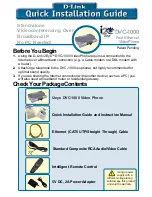
Network Configuration Concepts
201
VOICE-OVER-IP INSTALLATION REQUIREMENTS
It is essential to assess and configure the network in order to maintain the voice quality and
functionality for the user. This may require that an existing network be changed, or that
equipment with certain capabilities be installed.
The main network issues affecting voice quality are
•
delay
•
jitter
•
packet loss
Care has been taken in the design of the IP phones and controllers to reduce echo through the
inclusion of echo cancellation devices. Jitter and a certain degree of packet loss are also taken
care of by jitter buffers. For more information on these possible network issues, see “Basic
Concepts” on page 203.
Each Mitel device uses a jitter buffer that has been optimized for the device's intended usage:
•
52xx and 53xx IP Phones use an 800 ms dynamically adjustable jitter buffer.
•
The 3300 ICP controllers use an 800 ms dynamically adjustable jitter buffer.
•
Teleworker uses a 1600 ms jitter buffer on the internet side.
Before implementing a network to handle VoIP, consider the following areas (these are
recommendations, and there will always be exceptions):
•
QoS (Quality of Service)
Quality of service is that which is provided to the user, not network
equipment settings. However, certain network equipment configurations can greatly assist
in ensuring adequate QoS to a user. These include
-
IEEE 802.1p/Q (802.1Q VLAN now included as part of 802.1d)
: This is also known
as VLAN tagging, priority, or COS (different from the PBX/telecom Class of Service).
IEEE 802.1p/Q operates at Layer 2 to ensure the highest priority for voice traffic.
-
DiffServ (also known as DSCP)
: DiffServ is a fixed field in the Layer 3 information
that is also used to define different service categories through TOS, priority, and
precedence. DiffServ and Type of Service are similar. The older Type-of-Service
values are compatible with the newer DiffServ values.
•
Switched networks
: Use switched networks, which then allow full-bandwidth capability to
all endpoints. Networks with hubs include shared bandwidth; no priority mechanisms are
available.
•
Network topology
: Networks should be designed in a hierarchical manner where band-
width between devices is controlled and understood. Simply linking switches in a long chain
will work for data, but it introduces jitter and unnecessary bottlenecks between devices.
•
Network pre-installation and post-installation analysis
: The network should be inves-
tigated before installation to determine suitability for VoIP. Once an installation is completed,
it should also be tested to ensure that the guideline limits have not been exceeded.
•
Network address translation (NAT) and firewall
: Although there are emerging standards
to allow VoIP through firewalls and NAT devices, these are still in early development. To
Summary of Contents for MiVOICE BUSINESS
Page 1: ...Mitel MiVoice Business RELEASE 7 2 ENGINEERING GUIDELINES ...
Page 15: ...Chapter 1 ABOUT THIS DOCUMENT ...
Page 16: ......
Page 22: ...Engineering Guidelines 8 ...
Page 23: ...Chapter 2 SYSTEM OVERVIEW ...
Page 24: ......
Page 28: ...Engineering Guidelines 14 ...
Page 29: ...Chapter 3 TYPICAL CONFIGURATIONS ...
Page 30: ......
Page 73: ...Chapter 4 PHONES AND VOICE APPLICATIONS ...
Page 74: ......
Page 95: ...Phones and Voice Applications 81 Figure 9 ICP Connection Paths and Limitations ...
Page 100: ...Engineering Guidelines 86 ...
Page 101: ...Chapter 5 POWER ...
Page 102: ......
Page 128: ...Engineering Guidelines 114 ...
Page 129: ...Chapter 6 PERFORMANCE ...
Page 130: ......
Page 135: ...Chapter 7 APPLICATIONS ...
Page 136: ......
Page 142: ...Engineering Guidelines 128 ...
Page 143: ...Chapter 8 EMERGENCY SERVICES ...
Page 144: ......
Page 151: ...Chapter 9 IP NETWORKING ...
Page 152: ......
Page 167: ...Chapter 10 LICENSING ...
Page 168: ......
Page 183: ...Chapter 11 BANDWIDTH CODECS AND COMPRESSION ...
Page 184: ......
Page 209: ...Chapter 12 NETWORK CONFIGURATION CONCEPTS ...
Page 210: ......
Page 244: ...Engineering Guidelines 230 ...
Page 245: ...Chapter 13 NETWORK CONFIGURATION SPECIFICS ...
Page 246: ......
Page 309: ...Appendix A CAT 3 WIRING ...
Page 310: ......
Page 315: ...CAT 3 Wiring 301 Figure 55 CX MX MXe AX and LX Minimum Cable Standard ...
Page 316: ...Engineering Guidelines 302 ...
Page 317: ...Appendix B INSTALLATION EXAMPLES ...
Page 318: ......
Page 335: ...Appendix C LLDP AND LLDP MED CONFIGURATION EXAMPLES ...
Page 336: ......
Page 347: ...Appendix D VOIP AND VLANS ...
Page 348: ......
Page 353: ...Appendix E VOIP SECURITY ...
Page 354: ......
Page 381: ... ...
















































